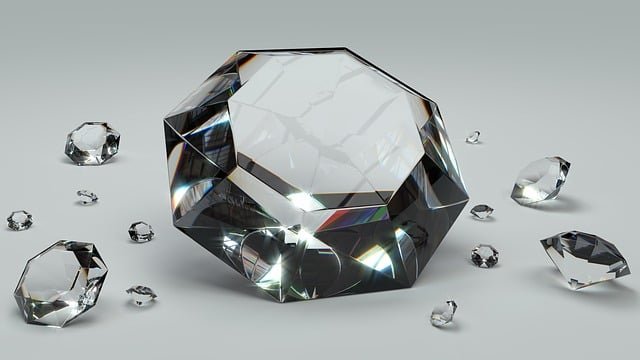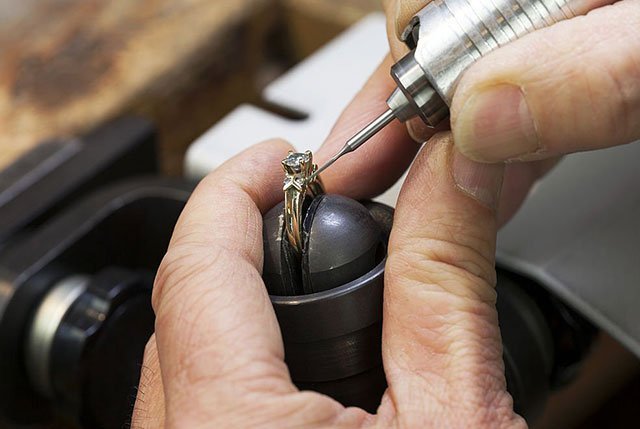Diamonds are some of the most precious and valuable stones in the world. Their beauty and rarity make them highly sought after, but even the most perfect diamond can develop flaws over time. One of the most common flaws that can occur in a diamond is the appearance of black spots. These spots can detract from the diamond’s beauty and value, but fortunately, there are ways to remove them.
If you have noticed black spots in your diamond, you may be wondering how to get rid of them. The good news is that there are several methods that can be used to remove these spots and restore the diamond’s brilliance. In this article, we will explore these methods in detail and provide you with the information you need to effectively remove black spots from your diamond.
Whether you have a family heirloom that has developed black spots over time or you have recently purchased a diamond that has imperfections, it is important to know how to properly care for and maintain your precious stone. By following the tips and techniques outlined in this article, you can keep your diamond looking its best and ensure that it remains a treasured possession for years to come.

Understanding Black Spots in Diamonds
Black spots in diamonds are a common concern for many diamond owners. These spots are also known as inclusions, which are natural imperfections that occur during the diamond’s formation process. Inclusions can be caused by various factors, such as mineral deposits, fractures, and air bubbles.
Inclusions can affect the diamond’s clarity and overall appearance. If the inclusions are visible to the naked eye, they can significantly reduce the diamond’s value. However, not all inclusions are bad. Some inclusions can actually enhance the diamond’s beauty and uniqueness.
When it comes to black spots in diamonds, it’s important to understand that not all black spots are the same. Some black spots may be caused by carbon deposits, which can be removed through various treatments. However, other black spots may be caused by fractures or other types of inclusions, which cannot be removed.
It’s also important to note that black spots can be more visible in certain diamond shapes and cuts. For example, emerald-cut diamonds have larger facets that can make inclusions more visible, including black spots. On the other hand, round brilliant-cut diamonds have smaller facets that can help hide inclusions.
In conclusion, black spots in diamonds are a natural occurrence that can affect the diamond’s value and appearance. Understanding the cause of black spots and the different types of inclusions can help diamond owners make informed decisions about their diamonds.
Causes of Black Spots in Diamonds
Black spots in diamonds can be caused by a variety of factors. Understanding these causes can help you prevent black spots from forming in the first place and take appropriate measures to remove them if they do appear.
Inclusions
Inclusions are tiny imperfections that are present inside a diamond. They can be caused by a variety of factors, including the diamond’s formation process and external factors such as pressure and temperature changes. Inclusions can appear as black spots or other dark areas within the diamond, and they can be difficult to remove.
Carbon Spots
Carbon spots are another common cause of black spots in diamonds. These are small black or dark gray areas that are caused by the presence of carbon within the diamond. Carbon spots are often caused by external factors such as heat and pressure, and they can be difficult to remove.
Poor Cutting
Diamonds that are poorly cut can also develop black spots. This is because the cut can affect the way that light enters and exits the diamond, which can cause dark areas to appear. Poor cutting can also cause other issues such as reduced brilliance and fire.
Treatment
Some diamonds are treated with various chemicals and processes to enhance their appearance. While these treatments can be effective in improving the diamond’s color and clarity, they can also cause black spots to appear. This is particularly true if the treatment is not performed properly or if the diamond is exposed to high temperatures or other damaging conditions.
Conclusion
In summary, black spots in diamonds can be caused by a variety of factors, including inclusions, carbon spots, poor cutting, and treatment. By understanding these causes, you can take steps to prevent black spots from forming in the first place and take appropriate measures to remove them if they do appear.
Prevention of Black Spots in Diamonds
We all know that black spots in diamonds can be a real eyesore, and it’s important to take preventative measures to avoid this issue. Here are a few tips to help prevent black spots from forming in your diamonds.
1. Avoid High Heat
Diamonds can be damaged by high heat, which can cause black spots to form. So, it’s important to avoid exposing your diamonds to high temperatures. This means avoiding things like hot tubs, saunas, and even leaving your diamond jewelry in your car on a hot day.
2. Regular Cleaning
Regular cleaning of your diamond jewelry can help prevent the formation of black spots. Dirt and grime can build up on your diamonds, and this can contribute to the formation of black spots. So, make sure to clean your diamond jewelry regularly with a soft-bristled brush and a mild soap solution.
3. Proper Storage
Proper storage of your diamond jewelry can also help prevent black spots from forming. When you’re not wearing your diamond jewelry, make sure to store it in a cool, dry place. Avoid storing your diamond jewelry in areas that are exposed to high heat or humidity, as this can contribute to the formation of black spots.
4. Avoid Chemicals
Chemicals can also contribute to the formation of black spots in diamonds. So, it’s important to avoid exposing your diamond jewelry to chemicals like chlorine, bleach, and other harsh cleaning agents. If you need to clean your diamond jewelry, make sure to use a mild soap solution and a soft-bristled brush.
By following these simple tips, you can help prevent black spots from forming in your diamonds, and keep your diamond jewelry looking beautiful for years to come.

Professional Cleaning Services
If you want your diamond to look its best, professional cleaning services can be an excellent option. Here are some things to consider.
Benefits of Professional Cleaning
Professional cleaning services offer several benefits. First, professionals have access to specialized equipment and cleaning solutions that can remove dirt and grime from your diamond more effectively than at-home methods. Second, professionals can inspect your diamond for damage and make recommendations for repairs or maintenance. Finally, professional cleaning can help your diamond shine like new again, which can be especially important if you plan to sell or give the diamond as a gift.
Finding a Trusted Professional
When choosing a professional cleaner, it’s important to do your research. Look for a provider with a good reputation and positive reviews from past customers. You can also check with industry organizations, such as the Gemological Institute of America, to find certified professionals in your area. Be sure to ask about the provider’s experience and qualifications, as well as their pricing and turnaround time. Finally, make sure that the provider is insured and offers a guarantee on their work.
Home Remedies for Cleaning Diamonds
If you’re looking to clean your diamond at home, there are a few home remedies that you can try. Keep in mind that these methods are not guaranteed to work on all diamonds, and you should be careful not to damage your diamond in the process.
Mild Detergent Solution
To clean your diamond with a mild detergent solution, mix a few drops of mild dish soap in a bowl of warm water. Soak your diamond in the solution for a few minutes, and then use a soft-bristled brush to gently scrub the diamond. Rinse the diamond in warm water and dry it with a soft, lint-free cloth.
Baking Soda Paste
To create a baking soda paste, mix baking soda with water until it forms a thick paste. Apply the paste to your diamond and let it sit for a few minutes. Use a soft-bristled brush to gently scrub the diamond, and then rinse it in warm water. Dry the diamond with a soft, lint-free cloth.
Vinegar Solution
To clean your diamond with a vinegar solution, mix equal parts water and white vinegar in a bowl. Soak your diamond in the solution for a few minutes, and then use a soft-bristled brush to gently scrub the diamond. Rinse the diamond in warm water and dry it with a soft, lint-free cloth.
Remember to be gentle when cleaning your diamond, and avoid using any harsh chemicals or abrasive materials that could scratch or damage the diamond. If you’re unsure about how to clean your diamond, it’s always best to take it to a professional jeweler for cleaning.
Considerations When Cleaning Diamonds at Home
Cleaning your diamond at home can be a cost-effective and convenient option, but it’s important to take certain considerations into account to avoid damaging your precious stone. Here are some things to keep in mind:
1. Know Your Diamond
Before cleaning your diamond, it’s important to know what type of diamond you have. Diamonds can be treated with different methods, such as heat or irradiation, which can affect how they should be cleaned. If you’re not sure about the treatment your diamond has received, it’s best to consult with a professional jeweler.
2. Choose the Right Cleaning Solution
There are many cleaning solutions available on the market, but not all of them are suitable for diamonds. Avoid using harsh chemicals, such as bleach or ammonia, which can damage your diamond. Instead, opt for a gentle cleaning solution specifically designed for diamonds.
3. Use a Soft Brush
When cleaning your diamond, use a soft-bristled brush to avoid scratching the surface. A toothbrush or makeup brush can work well. Be sure to brush gently, and avoid using too much pressure.
4. Dry Your Diamond Properly
After cleaning your diamond, it’s important to dry it properly to avoid water spots. Use a soft, lint-free cloth to gently pat your diamond dry. Avoid using a hair dryer or other heat source, which can damage your diamond.
5. Consider Professional Cleaning
If you’re unsure about cleaning your diamond at home, or if your diamond has significant dirt or grime buildup, it may be best to take it to a professional jeweler for cleaning. They have the expertise and equipment to clean your diamond safely and effectively.
By following these considerations, you can keep your diamond looking its best for years to come.
When to Replace a Diamond
Sometimes, the damage to a diamond is too severe to be repaired. In such cases, the only option is to replace the diamond. Here are some situations where replacing the diamond is necessary:
- Large chips or cracks: If the diamond has a large chip or crack that cannot be repaired, it may need to be replaced. This is especially true if the damage is on the top or side of the diamond, as it can affect the diamond’s overall appearance.
- Deep scratches: If the diamond has deep scratches that cannot be polished out, it may need to be replaced. Deep scratches can affect the diamond’s clarity and brilliance, making it look dull and lifeless.
- Multiple chips or cracks: If the diamond has multiple chips or cracks, it may be more cost-effective to replace the diamond rather than repairing it. This is because repairing multiple chips or cracks can be time-consuming and expensive.
- Significant loss of carat weight: If the diamond has lost a significant amount of carat weight due to damage, it may need to be replaced. This is because the diamond’s value is largely based on its carat weight, and a significant loss can greatly reduce its value.
It is important to note that not all damage requires a diamond to be replaced. Minor chips, scratches, and other damage can often be repaired by a professional jeweler. However, if you are unsure whether your diamond can be repaired or needs to be replaced, it is best to consult a professional.
Conclusion
In conclusion, getting rid of black spots in diamonds is possible, but it requires careful consideration and professional expertise. As we have discussed in this article, black spots in diamonds can be caused by various factors, including inclusions, blemishes, and natural features.
To remove black spots in diamonds, we recommend seeking the assistance of a professional jeweler or diamond expert. They can help identify the cause of the black spot and recommend the best course of action.
In some cases, the black spot may be too deep or extensive to remove completely. However, a skilled jeweler can minimize its appearance by re-cutting the diamond or using other techniques.
It’s important to note that not all black spots in diamonds are bad. Some black spots can add character and uniqueness to a diamond, making it more valuable. It’s essential to have a professional evaluate the diamond before attempting to remove any black spots.
In summary, if you have a diamond with a black spot, don’t panic. Seek the advice of a professional and trust their expertise. With proper care and attention, you can restore your diamond’s natural beauty and value.

Frequently Asked Questions
How do you remove black spots from diamonds?
Removing black spots from diamonds can be a difficult task and may require professional assistance. It is important to note that not all black spots can be removed, and attempting to remove them may cause further damage to the diamond. We recommend taking your diamond to a trusted jeweler or diamond specialist for evaluation and potential cleaning options.
What causes black spots to appear in diamonds?
Black spots in diamonds can be caused by a variety of factors, including natural inclusions, internal fractures, and damage from wear and tear. In some cases, black spots may also be caused by exposure to high temperatures or chemicals.
Are black spots in diamonds a sign of damage?
Black spots in diamonds can be a sign of damage, but not always. As mentioned before, some black spots are natural inclusions and do not affect the structural integrity of the diamond. However, if the black spot is caused by internal fractures or damage from wear and tear, it may indicate a weakened diamond.
Can black spots in diamonds be prevented?
Preventing black spots in diamonds can be difficult, as they can be caused by a variety of factors. However, taking proper care of your diamond and avoiding exposure to high temperatures and chemicals can help prevent damage that may result in black spots.
What are the best cleaning methods for diamonds with black spots?
Cleaning diamonds with black spots should be done with caution, as aggressive cleaning methods may cause further damage. We recommend using a soft-bristled brush and a mild cleaning solution to gently clean the diamond. If the black spot persists, it may be necessary to seek professional cleaning services.
Do lab-created diamonds have a higher likelihood of developing black spots?
Lab-created diamonds have a similar likelihood of developing black spots as natural diamonds. However, since lab-created diamonds are created in a controlled environment, they may have fewer natural inclusions than natural diamonds, which may result in a lower likelihood of black spots.





